Report on Anxiety Study: Exploring Academic Performance and Stress
VerifiedAdded on 2023/06/08
|13
|3147
|253
Report
AI Summary
This report presents a study on the prevalence of anxiety among college students, exploring the relationship between academic performance and mental health. The study investigates the hypothesis that students with higher GPAs experience lower anxiety levels. Conducted using a structured quest...

Report on Anxiety Study
Student Name:
Institute Name:
Student Name:
Institute Name:
Paraphrase This Document
Need a fresh take? Get an instant paraphrase of this document with our AI Paraphraser

Abstract
The 21st century is slowly becoming the breeding ground for all sorts of mental illnesses, of
which anxiety is the most common one and is spreading like wild forest fire. People are
constantly under pressure to perform well and outperform themselves every now and then,
and the epicentre of this pressure starts building during the young age itself. Here, the
pressure to score good in college and get into a good college is such a big deal that often
students are diagnosed with depression and anxiety. Anxiety is something which can arise in
a person due to many reasons, stress being one of the main reasons for the same.
Now while many people refute these claims and say that college is a cake walk and builds no
pressure on the young minds, it is rightly said that they often end up building so much inside
of them that it eventually turns their health upside down. Mental health is of great
importance, and in this study aims to explore the established hypothesis that people who
score well in college are in less pressure and have fewer anxiety levels than the ones who do
not. While there can be various other reasons for this stress, we shall aim to explore it in this
consistent manner. The study will be exploratory in nature and will aim to understand the
various factors which have led to the establishment of this hypothesis. The questionnaire has
been formed on basis of STAI. STAI is a commonly used measure of trait and state anxiety
and is measured on a four-point scale.
The results obtained from this will tell us about how this hypothesis will affect our
understanding of anxiety, and how we can go about it in young people, earlier in their age
itself.
Keywords: anxiety, stress, college, college, education, success
The 21st century is slowly becoming the breeding ground for all sorts of mental illnesses, of
which anxiety is the most common one and is spreading like wild forest fire. People are
constantly under pressure to perform well and outperform themselves every now and then,
and the epicentre of this pressure starts building during the young age itself. Here, the
pressure to score good in college and get into a good college is such a big deal that often
students are diagnosed with depression and anxiety. Anxiety is something which can arise in
a person due to many reasons, stress being one of the main reasons for the same.
Now while many people refute these claims and say that college is a cake walk and builds no
pressure on the young minds, it is rightly said that they often end up building so much inside
of them that it eventually turns their health upside down. Mental health is of great
importance, and in this study aims to explore the established hypothesis that people who
score well in college are in less pressure and have fewer anxiety levels than the ones who do
not. While there can be various other reasons for this stress, we shall aim to explore it in this
consistent manner. The study will be exploratory in nature and will aim to understand the
various factors which have led to the establishment of this hypothesis. The questionnaire has
been formed on basis of STAI. STAI is a commonly used measure of trait and state anxiety
and is measured on a four-point scale.
The results obtained from this will tell us about how this hypothesis will affect our
understanding of anxiety, and how we can go about it in young people, earlier in their age
itself.
Keywords: anxiety, stress, college, college, education, success
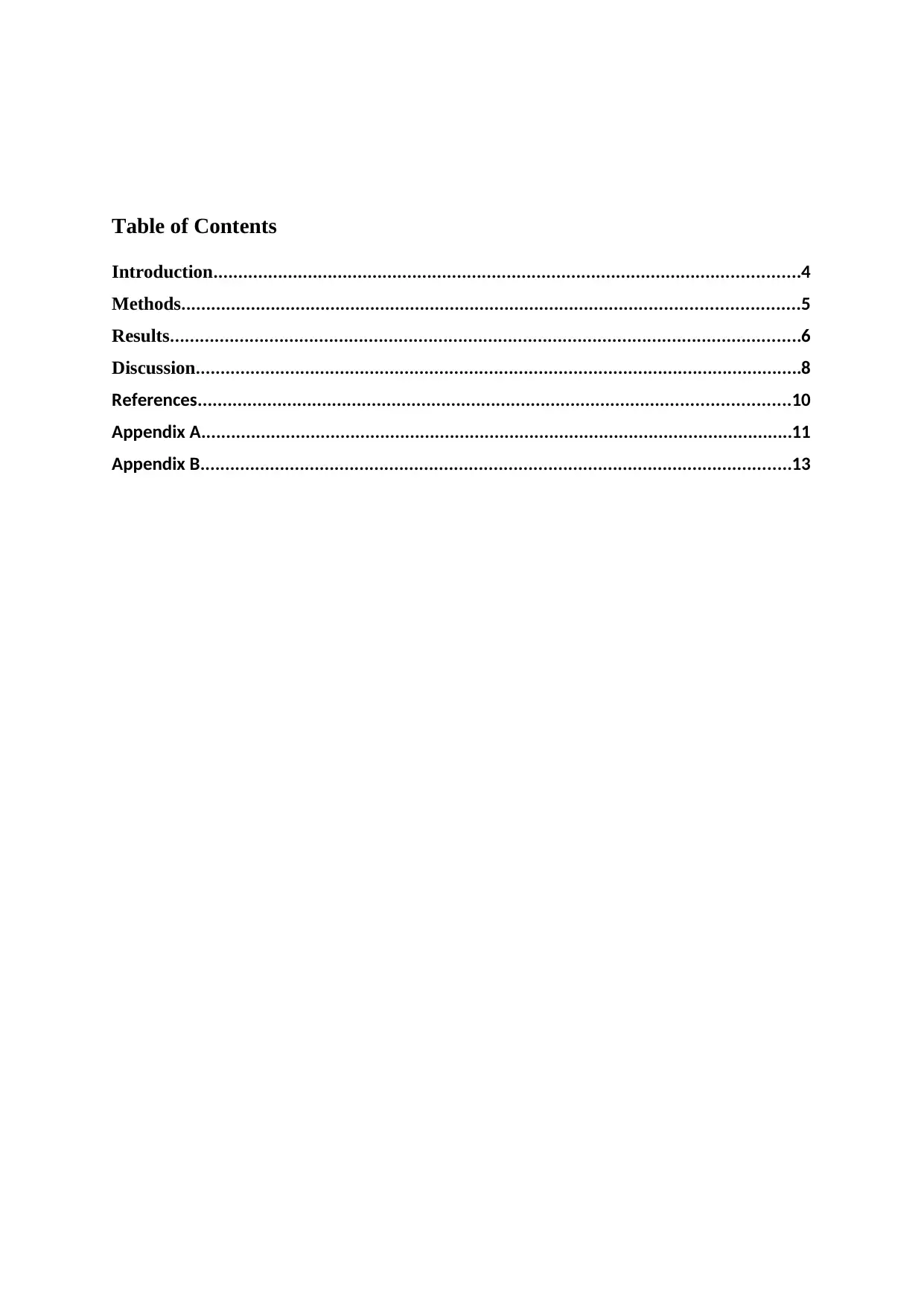
Table of Contents
Introduction......................................................................................................................4
Methods............................................................................................................................5
Results...............................................................................................................................6
Discussion..........................................................................................................................8
References.......................................................................................................................10
Appendix A.......................................................................................................................11
Appendix B.......................................................................................................................13
Introduction......................................................................................................................4
Methods............................................................................................................................5
Results...............................................................................................................................6
Discussion..........................................................................................................................8
References.......................................................................................................................10
Appendix A.......................................................................................................................11
Appendix B.......................................................................................................................13
⊘ This is a preview!⊘
Do you want full access?
Subscribe today to unlock all pages.

Trusted by 1+ million students worldwide
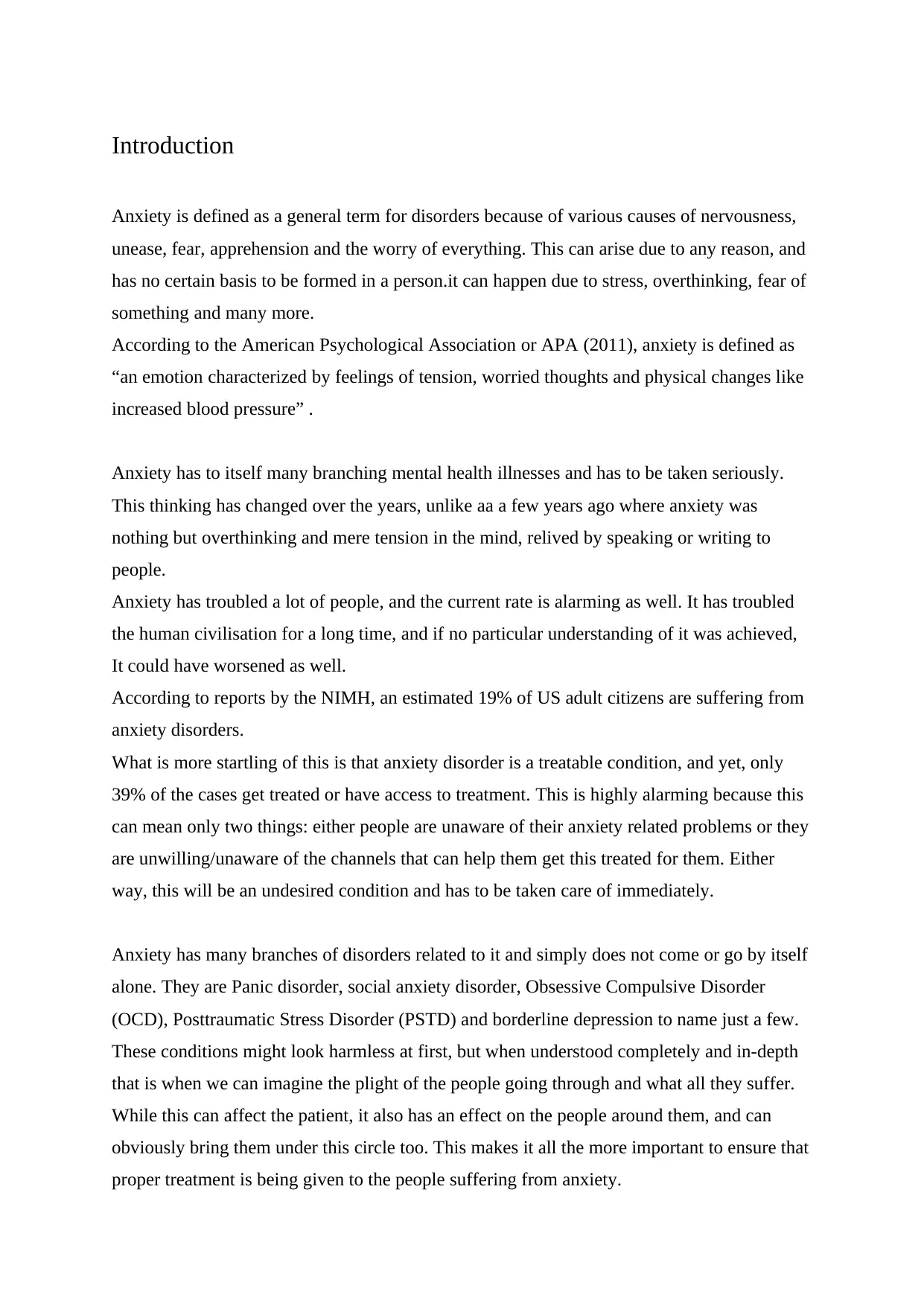
Introduction
Anxiety is defined as a general term for disorders because of various causes of nervousness,
unease, fear, apprehension and the worry of everything. This can arise due to any reason, and
has no certain basis to be formed in a person.it can happen due to stress, overthinking, fear of
something and many more.
According to the American Psychological Association or APA (2011), anxiety is defined as
“an emotion characterized by feelings of tension, worried thoughts and physical changes like
increased blood pressure” .
Anxiety has to itself many branching mental health illnesses and has to be taken seriously.
This thinking has changed over the years, unlike aa a few years ago where anxiety was
nothing but overthinking and mere tension in the mind, relived by speaking or writing to
people.
Anxiety has troubled a lot of people, and the current rate is alarming as well. It has troubled
the human civilisation for a long time, and if no particular understanding of it was achieved,
It could have worsened as well.
According to reports by the NIMH, an estimated 19% of US adult citizens are suffering from
anxiety disorders.
What is more startling of this is that anxiety disorder is a treatable condition, and yet, only
39% of the cases get treated or have access to treatment. This is highly alarming because this
can mean only two things: either people are unaware of their anxiety related problems or they
are unwilling/unaware of the channels that can help them get this treated for them. Either
way, this will be an undesired condition and has to be taken care of immediately.
Anxiety has many branches of disorders related to it and simply does not come or go by itself
alone. They are Panic disorder, social anxiety disorder, Obsessive Compulsive Disorder
(OCD), Posttraumatic Stress Disorder (PSTD) and borderline depression to name just a few.
These conditions might look harmless at first, but when understood completely and in-depth
that is when we can imagine the plight of the people going through and what all they suffer.
While this can affect the patient, it also has an effect on the people around them, and can
obviously bring them under this circle too. This makes it all the more important to ensure that
proper treatment is being given to the people suffering from anxiety.
Anxiety is defined as a general term for disorders because of various causes of nervousness,
unease, fear, apprehension and the worry of everything. This can arise due to any reason, and
has no certain basis to be formed in a person.it can happen due to stress, overthinking, fear of
something and many more.
According to the American Psychological Association or APA (2011), anxiety is defined as
“an emotion characterized by feelings of tension, worried thoughts and physical changes like
increased blood pressure” .
Anxiety has to itself many branching mental health illnesses and has to be taken seriously.
This thinking has changed over the years, unlike aa a few years ago where anxiety was
nothing but overthinking and mere tension in the mind, relived by speaking or writing to
people.
Anxiety has troubled a lot of people, and the current rate is alarming as well. It has troubled
the human civilisation for a long time, and if no particular understanding of it was achieved,
It could have worsened as well.
According to reports by the NIMH, an estimated 19% of US adult citizens are suffering from
anxiety disorders.
What is more startling of this is that anxiety disorder is a treatable condition, and yet, only
39% of the cases get treated or have access to treatment. This is highly alarming because this
can mean only two things: either people are unaware of their anxiety related problems or they
are unwilling/unaware of the channels that can help them get this treated for them. Either
way, this will be an undesired condition and has to be taken care of immediately.
Anxiety has many branches of disorders related to it and simply does not come or go by itself
alone. They are Panic disorder, social anxiety disorder, Obsessive Compulsive Disorder
(OCD), Posttraumatic Stress Disorder (PSTD) and borderline depression to name just a few.
These conditions might look harmless at first, but when understood completely and in-depth
that is when we can imagine the plight of the people going through and what all they suffer.
While this can affect the patient, it also has an effect on the people around them, and can
obviously bring them under this circle too. This makes it all the more important to ensure that
proper treatment is being given to the people suffering from anxiety.
Paraphrase This Document
Need a fresh take? Get an instant paraphrase of this document with our AI Paraphraser
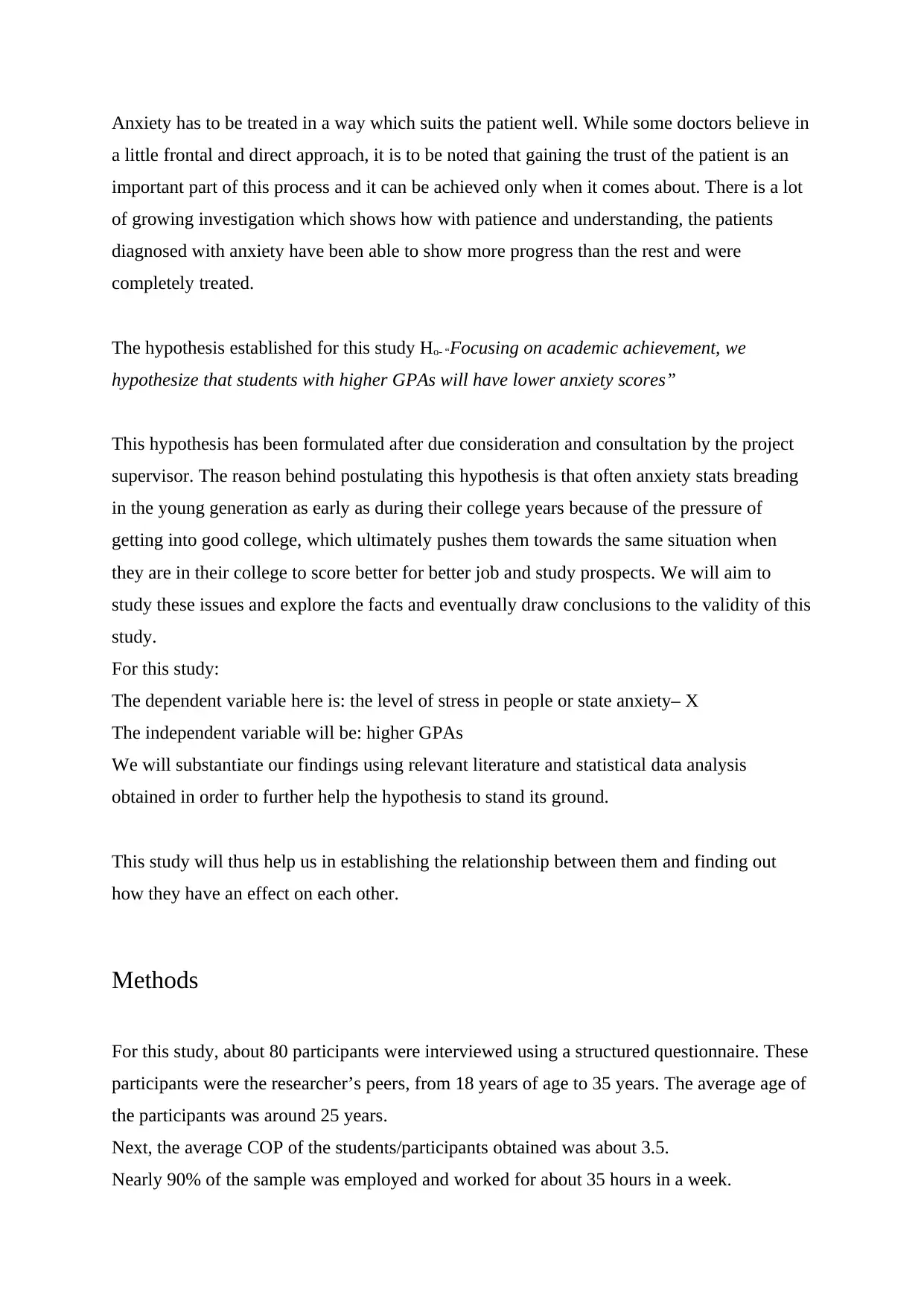
Anxiety has to be treated in a way which suits the patient well. While some doctors believe in
a little frontal and direct approach, it is to be noted that gaining the trust of the patient is an
important part of this process and it can be achieved only when it comes about. There is a lot
of growing investigation which shows how with patience and understanding, the patients
diagnosed with anxiety have been able to show more progress than the rest and were
completely treated.
The hypothesis established for this study Ho- “Focusing on academic achievement, we
hypothesize that students with higher GPAs will have lower anxiety scores”
This hypothesis has been formulated after due consideration and consultation by the project
supervisor. The reason behind postulating this hypothesis is that often anxiety stats breading
in the young generation as early as during their college years because of the pressure of
getting into good college, which ultimately pushes them towards the same situation when
they are in their college to score better for better job and study prospects. We will aim to
study these issues and explore the facts and eventually draw conclusions to the validity of this
study.
For this study:
The dependent variable here is: the level of stress in people or state anxiety– X
The independent variable will be: higher GPAs
We will substantiate our findings using relevant literature and statistical data analysis
obtained in order to further help the hypothesis to stand its ground.
This study will thus help us in establishing the relationship between them and finding out
how they have an effect on each other.
Methods
For this study, about 80 participants were interviewed using a structured questionnaire. These
participants were the researcher’s peers, from 18 years of age to 35 years. The average age of
the participants was around 25 years.
Next, the average COP of the students/participants obtained was about 3.5.
Nearly 90% of the sample was employed and worked for about 35 hours in a week.
a little frontal and direct approach, it is to be noted that gaining the trust of the patient is an
important part of this process and it can be achieved only when it comes about. There is a lot
of growing investigation which shows how with patience and understanding, the patients
diagnosed with anxiety have been able to show more progress than the rest and were
completely treated.
The hypothesis established for this study Ho- “Focusing on academic achievement, we
hypothesize that students with higher GPAs will have lower anxiety scores”
This hypothesis has been formulated after due consideration and consultation by the project
supervisor. The reason behind postulating this hypothesis is that often anxiety stats breading
in the young generation as early as during their college years because of the pressure of
getting into good college, which ultimately pushes them towards the same situation when
they are in their college to score better for better job and study prospects. We will aim to
study these issues and explore the facts and eventually draw conclusions to the validity of this
study.
For this study:
The dependent variable here is: the level of stress in people or state anxiety– X
The independent variable will be: higher GPAs
We will substantiate our findings using relevant literature and statistical data analysis
obtained in order to further help the hypothesis to stand its ground.
This study will thus help us in establishing the relationship between them and finding out
how they have an effect on each other.
Methods
For this study, about 80 participants were interviewed using a structured questionnaire. These
participants were the researcher’s peers, from 18 years of age to 35 years. The average age of
the participants was around 25 years.
Next, the average COP of the students/participants obtained was about 3.5.
Nearly 90% of the sample was employed and worked for about 35 hours in a week.

The questionnaire was a structured questionnaire aimed at understanding the background of
the participants which included their college education, CGP, employment status and how
much they worked. This questionnaire gave us insights on understanding the kind of
environment these people work in and how according to the established hypothesis, the CGP
has affected their future course of life.
The questionnaire has been formed on basis of STAI. STAI is a commonly used measure of
trait and state anxiety. The form has 20 questions to assess trait anxiety and other 20 to assess
state anxiety.
The setting for the interview was the classroom as it provided the right environment.
Items of trait anxiety are: “I worry too much over something that really doesn’t matter”
Items of trait anxiety are: “I am tense; I am worried”
Both of them are measures on a four-point scale, with each value having the certain
parameter for the respondent to answer. However, these scales can change after treatment and
with due health considerations when followed properly (LAURA J. JULIAN, 2011).
Students were paired with other classmate and were interviewed using a questionnaire. In
order to remain anonymous subjects were to write their name on the questionnaire thus
having the interviewee's answers as their own.
This was completed in an in-class setting and was given the at least 45 min towards the end
of class to complete a questionnaire
After the questionnaire was taken back, the participants gave their feedback and how simple
it was for them to respond, and that they actually looked forward towards results to know if
they are suffering from anxiety or not.
Results
The results of this research are have been found after a detailed analysis of the data collected.
The sample size for this research was 75 people coming with different educational as well as
employment background.
the participants which included their college education, CGP, employment status and how
much they worked. This questionnaire gave us insights on understanding the kind of
environment these people work in and how according to the established hypothesis, the CGP
has affected their future course of life.
The questionnaire has been formed on basis of STAI. STAI is a commonly used measure of
trait and state anxiety. The form has 20 questions to assess trait anxiety and other 20 to assess
state anxiety.
The setting for the interview was the classroom as it provided the right environment.
Items of trait anxiety are: “I worry too much over something that really doesn’t matter”
Items of trait anxiety are: “I am tense; I am worried”
Both of them are measures on a four-point scale, with each value having the certain
parameter for the respondent to answer. However, these scales can change after treatment and
with due health considerations when followed properly (LAURA J. JULIAN, 2011).
Students were paired with other classmate and were interviewed using a questionnaire. In
order to remain anonymous subjects were to write their name on the questionnaire thus
having the interviewee's answers as their own.
This was completed in an in-class setting and was given the at least 45 min towards the end
of class to complete a questionnaire
After the questionnaire was taken back, the participants gave their feedback and how simple
it was for them to respond, and that they actually looked forward towards results to know if
they are suffering from anxiety or not.
Results
The results of this research are have been found after a detailed analysis of the data collected.
The sample size for this research was 75 people coming with different educational as well as
employment background.
⊘ This is a preview!⊘
Do you want full access?
Subscribe today to unlock all pages.

Trusted by 1+ million students worldwide
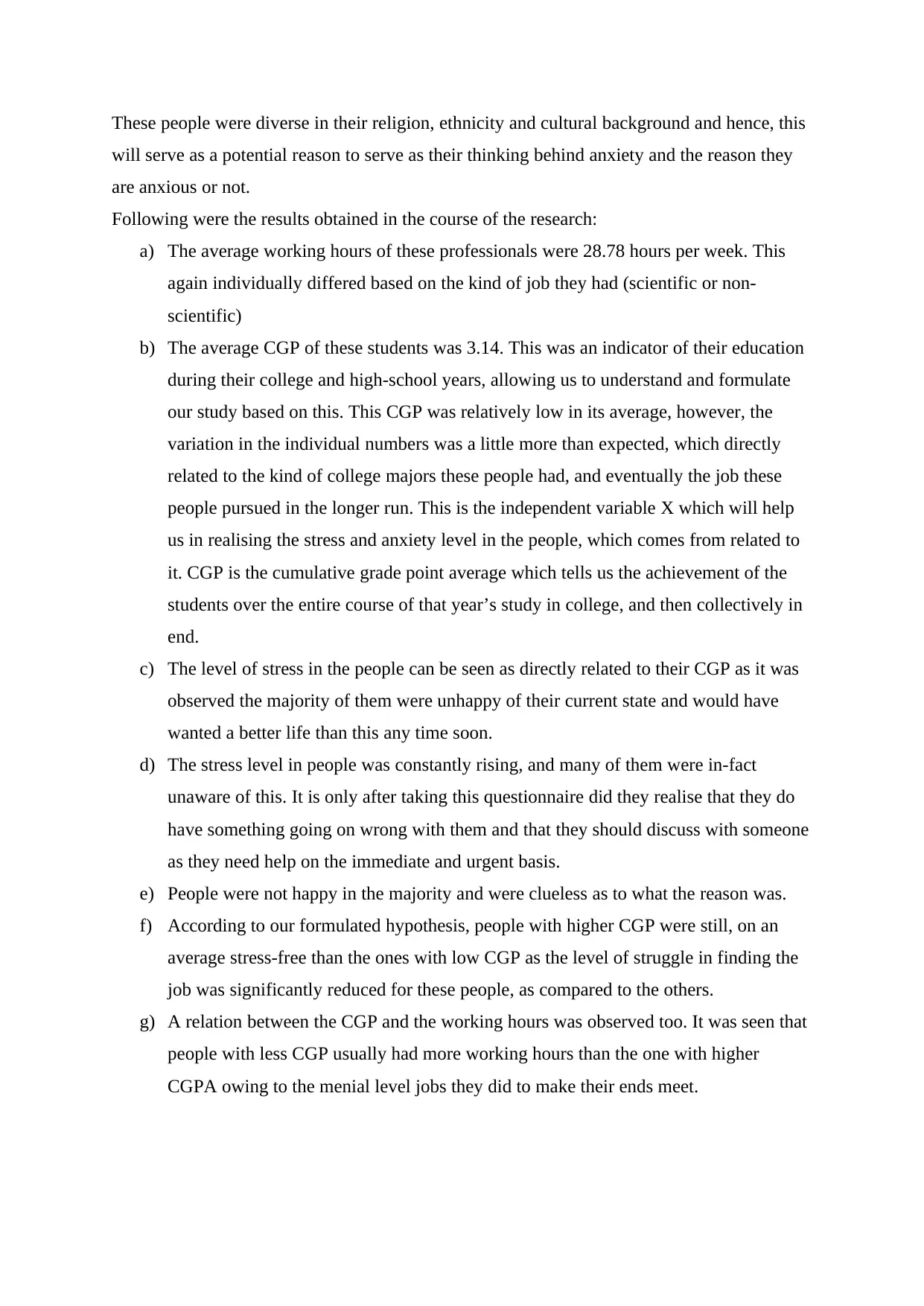
These people were diverse in their religion, ethnicity and cultural background and hence, this
will serve as a potential reason to serve as their thinking behind anxiety and the reason they
are anxious or not.
Following were the results obtained in the course of the research:
a) The average working hours of these professionals were 28.78 hours per week. This
again individually differed based on the kind of job they had (scientific or non-
scientific)
b) The average CGP of these students was 3.14. This was an indicator of their education
during their college and high-school years, allowing us to understand and formulate
our study based on this. This CGP was relatively low in its average, however, the
variation in the individual numbers was a little more than expected, which directly
related to the kind of college majors these people had, and eventually the job these
people pursued in the longer run. This is the independent variable X which will help
us in realising the stress and anxiety level in the people, which comes from related to
it. CGP is the cumulative grade point average which tells us the achievement of the
students over the entire course of that year’s study in college, and then collectively in
end.
c) The level of stress in the people can be seen as directly related to their CGP as it was
observed the majority of them were unhappy of their current state and would have
wanted a better life than this any time soon.
d) The stress level in people was constantly rising, and many of them were in-fact
unaware of this. It is only after taking this questionnaire did they realise that they do
have something going on wrong with them and that they should discuss with someone
as they need help on the immediate and urgent basis.
e) People were not happy in the majority and were clueless as to what the reason was.
f) According to our formulated hypothesis, people with higher CGP were still, on an
average stress-free than the ones with low CGP as the level of struggle in finding the
job was significantly reduced for these people, as compared to the others.
g) A relation between the CGP and the working hours was observed too. It was seen that
people with less CGP usually had more working hours than the one with higher
CGPA owing to the menial level jobs they did to make their ends meet.
will serve as a potential reason to serve as their thinking behind anxiety and the reason they
are anxious or not.
Following were the results obtained in the course of the research:
a) The average working hours of these professionals were 28.78 hours per week. This
again individually differed based on the kind of job they had (scientific or non-
scientific)
b) The average CGP of these students was 3.14. This was an indicator of their education
during their college and high-school years, allowing us to understand and formulate
our study based on this. This CGP was relatively low in its average, however, the
variation in the individual numbers was a little more than expected, which directly
related to the kind of college majors these people had, and eventually the job these
people pursued in the longer run. This is the independent variable X which will help
us in realising the stress and anxiety level in the people, which comes from related to
it. CGP is the cumulative grade point average which tells us the achievement of the
students over the entire course of that year’s study in college, and then collectively in
end.
c) The level of stress in the people can be seen as directly related to their CGP as it was
observed the majority of them were unhappy of their current state and would have
wanted a better life than this any time soon.
d) The stress level in people was constantly rising, and many of them were in-fact
unaware of this. It is only after taking this questionnaire did they realise that they do
have something going on wrong with them and that they should discuss with someone
as they need help on the immediate and urgent basis.
e) People were not happy in the majority and were clueless as to what the reason was.
f) According to our formulated hypothesis, people with higher CGP were still, on an
average stress-free than the ones with low CGP as the level of struggle in finding the
job was significantly reduced for these people, as compared to the others.
g) A relation between the CGP and the working hours was observed too. It was seen that
people with less CGP usually had more working hours than the one with higher
CGPA owing to the menial level jobs they did to make their ends meet.
Paraphrase This Document
Need a fresh take? Get an instant paraphrase of this document with our AI Paraphraser
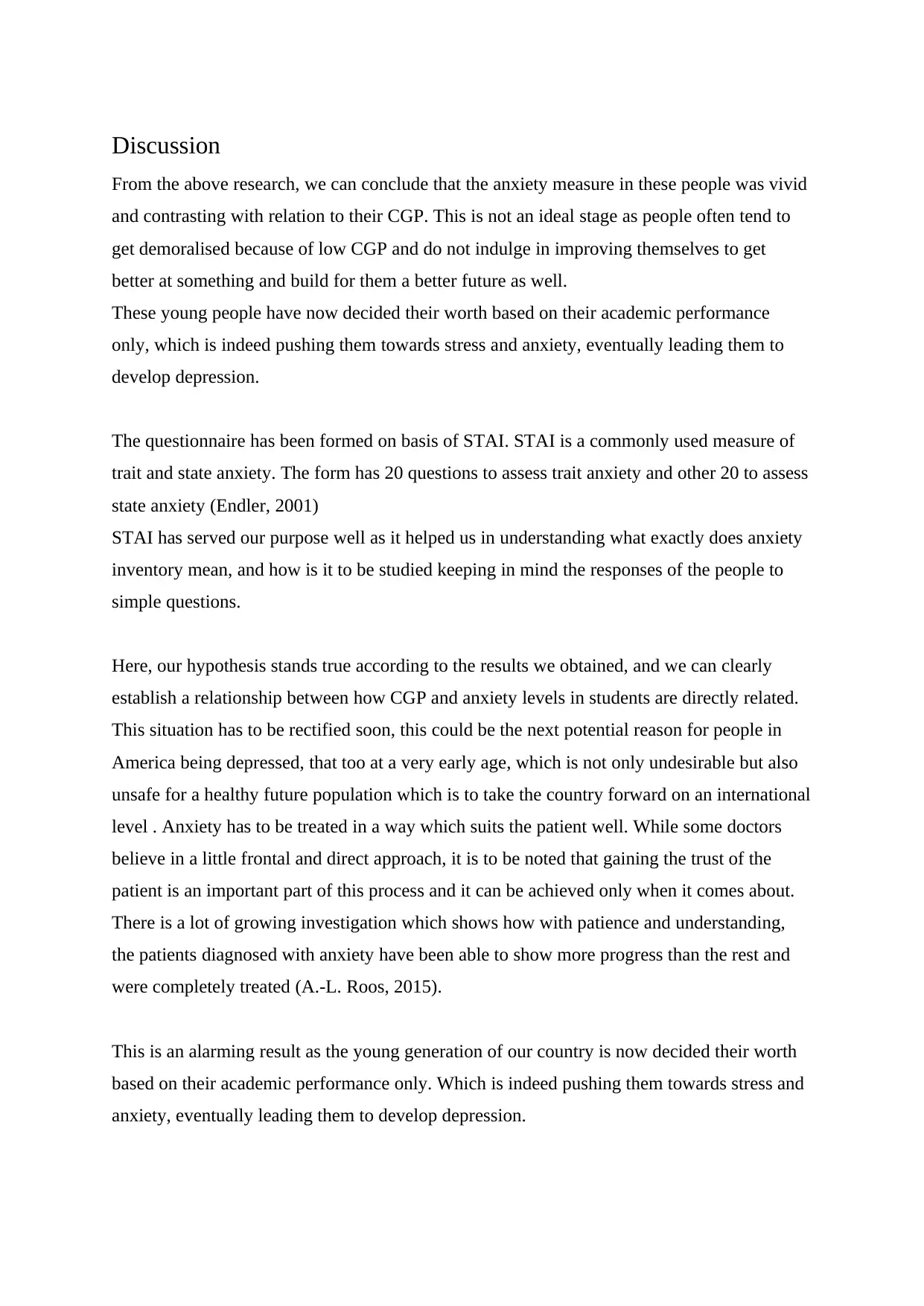
Discussion
From the above research, we can conclude that the anxiety measure in these people was vivid
and contrasting with relation to their CGP. This is not an ideal stage as people often tend to
get demoralised because of low CGP and do not indulge in improving themselves to get
better at something and build for them a better future as well.
These young people have now decided their worth based on their academic performance
only, which is indeed pushing them towards stress and anxiety, eventually leading them to
develop depression.
The questionnaire has been formed on basis of STAI. STAI is a commonly used measure of
trait and state anxiety. The form has 20 questions to assess trait anxiety and other 20 to assess
state anxiety (Endler, 2001)
STAI has served our purpose well as it helped us in understanding what exactly does anxiety
inventory mean, and how is it to be studied keeping in mind the responses of the people to
simple questions.
Here, our hypothesis stands true according to the results we obtained, and we can clearly
establish a relationship between how CGP and anxiety levels in students are directly related.
This situation has to be rectified soon, this could be the next potential reason for people in
America being depressed, that too at a very early age, which is not only undesirable but also
unsafe for a healthy future population which is to take the country forward on an international
level . Anxiety has to be treated in a way which suits the patient well. While some doctors
believe in a little frontal and direct approach, it is to be noted that gaining the trust of the
patient is an important part of this process and it can be achieved only when it comes about.
There is a lot of growing investigation which shows how with patience and understanding,
the patients diagnosed with anxiety have been able to show more progress than the rest and
were completely treated (A.-L. Roos, 2015).
This is an alarming result as the young generation of our country is now decided their worth
based on their academic performance only. Which is indeed pushing them towards stress and
anxiety, eventually leading them to develop depression.
From the above research, we can conclude that the anxiety measure in these people was vivid
and contrasting with relation to their CGP. This is not an ideal stage as people often tend to
get demoralised because of low CGP and do not indulge in improving themselves to get
better at something and build for them a better future as well.
These young people have now decided their worth based on their academic performance
only, which is indeed pushing them towards stress and anxiety, eventually leading them to
develop depression.
The questionnaire has been formed on basis of STAI. STAI is a commonly used measure of
trait and state anxiety. The form has 20 questions to assess trait anxiety and other 20 to assess
state anxiety (Endler, 2001)
STAI has served our purpose well as it helped us in understanding what exactly does anxiety
inventory mean, and how is it to be studied keeping in mind the responses of the people to
simple questions.
Here, our hypothesis stands true according to the results we obtained, and we can clearly
establish a relationship between how CGP and anxiety levels in students are directly related.
This situation has to be rectified soon, this could be the next potential reason for people in
America being depressed, that too at a very early age, which is not only undesirable but also
unsafe for a healthy future population which is to take the country forward on an international
level . Anxiety has to be treated in a way which suits the patient well. While some doctors
believe in a little frontal and direct approach, it is to be noted that gaining the trust of the
patient is an important part of this process and it can be achieved only when it comes about.
There is a lot of growing investigation which shows how with patience and understanding,
the patients diagnosed with anxiety have been able to show more progress than the rest and
were completely treated (A.-L. Roos, 2015).
This is an alarming result as the young generation of our country is now decided their worth
based on their academic performance only. Which is indeed pushing them towards stress and
anxiety, eventually leading them to develop depression.

Students are often more vulnerable about these things since often times their thinking process
is ruptured by the societal pressure of how achieving good grades is equated with being
successful and smart. This is a very bad practice as it does not give a good idea of the mental
health of our upcoming generation, which often times we are the ones destroying. This is how
Anxiety builds up in the people, and this is how it affects the young people as well.
is ruptured by the societal pressure of how achieving good grades is equated with being
successful and smart. This is a very bad practice as it does not give a good idea of the mental
health of our upcoming generation, which often times we are the ones destroying. This is how
Anxiety builds up in the people, and this is how it affects the young people as well.
⊘ This is a preview!⊘
Do you want full access?
Subscribe today to unlock all pages.

Trusted by 1+ million students worldwide

References
APA. (2011). Anxiety. Retrieved from www.apa.org: http://www.apa.org/topics/anxiety/
LAURA J. JULIAN. (2011). Measures of Anxiety. NIH Public Access, 63(110).
Endler, K. (2001). NIH Public Access. Journal of Anxiety Disorder , 15.
A.-L. Roos, M. B. (2015). hematics anxiety than expected? Contrasting trait and state anxiety
in high achieving students . High Ability Studies,, 26.
APA. (2011). Anxiety. Retrieved from www.apa.org: http://www.apa.org/topics/anxiety/
LAURA J. JULIAN. (2011). Measures of Anxiety. NIH Public Access, 63(110).
Endler, K. (2001). NIH Public Access. Journal of Anxiety Disorder , 15.
A.-L. Roos, M. B. (2015). hematics anxiety than expected? Contrasting trait and state anxiety
in high achieving students . High Ability Studies,, 26.
Paraphrase This Document
Need a fresh take? Get an instant paraphrase of this document with our AI Paraphraser
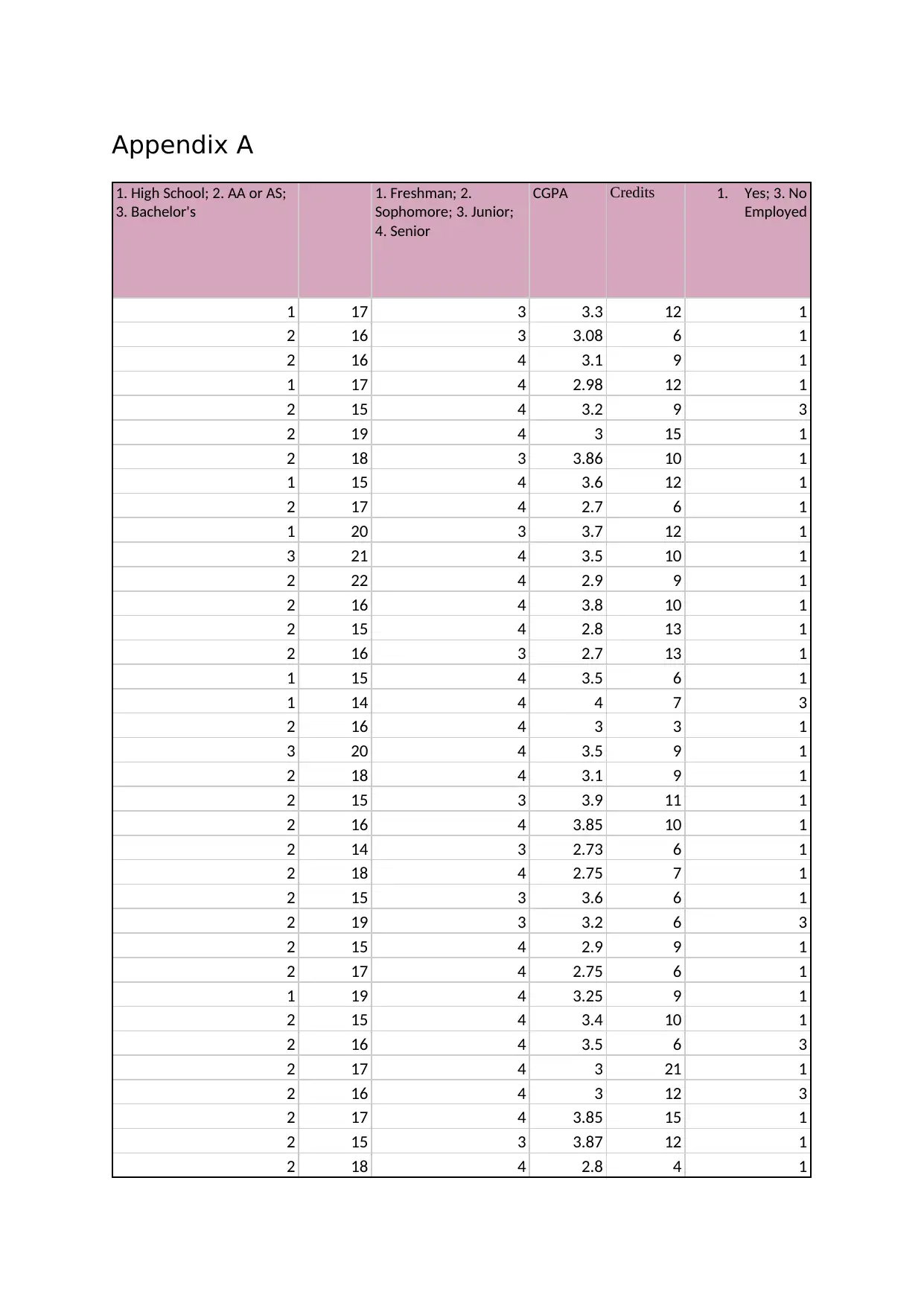
Appendix A
1. High School; 2. AA or AS;
3. Bachelor's
1. Freshman; 2.
Sophomore; 3. Junior;
4. Senior
CGPA Credits 1. Yes; 3. No
Employed
1 17 3 3.3 12 1
2 16 3 3.08 6 1
2 16 4 3.1 9 1
1 17 4 2.98 12 1
2 15 4 3.2 9 3
2 19 4 3 15 1
2 18 3 3.86 10 1
1 15 4 3.6 12 1
2 17 4 2.7 6 1
1 20 3 3.7 12 1
3 21 4 3.5 10 1
2 22 4 2.9 9 1
2 16 4 3.8 10 1
2 15 4 2.8 13 1
2 16 3 2.7 13 1
1 15 4 3.5 6 1
1 14 4 4 7 3
2 16 4 3 3 1
3 20 4 3.5 9 1
2 18 4 3.1 9 1
2 15 3 3.9 11 1
2 16 4 3.85 10 1
2 14 3 2.73 6 1
2 18 4 2.75 7 1
2 15 3 3.6 6 1
2 19 3 3.2 6 3
2 15 4 2.9 9 1
2 17 4 2.75 6 1
1 19 4 3.25 9 1
2 15 4 3.4 10 1
2 16 4 3.5 6 3
2 17 4 3 21 1
2 16 4 3 12 3
2 17 4 3.85 15 1
2 15 3 3.87 12 1
2 18 4 2.8 4 1
1. High School; 2. AA or AS;
3. Bachelor's
1. Freshman; 2.
Sophomore; 3. Junior;
4. Senior
CGPA Credits 1. Yes; 3. No
Employed
1 17 3 3.3 12 1
2 16 3 3.08 6 1
2 16 4 3.1 9 1
1 17 4 2.98 12 1
2 15 4 3.2 9 3
2 19 4 3 15 1
2 18 3 3.86 10 1
1 15 4 3.6 12 1
2 17 4 2.7 6 1
1 20 3 3.7 12 1
3 21 4 3.5 10 1
2 22 4 2.9 9 1
2 16 4 3.8 10 1
2 15 4 2.8 13 1
2 16 3 2.7 13 1
1 15 4 3.5 6 1
1 14 4 4 7 3
2 16 4 3 3 1
3 20 4 3.5 9 1
2 18 4 3.1 9 1
2 15 3 3.9 11 1
2 16 4 3.85 10 1
2 14 3 2.73 6 1
2 18 4 2.75 7 1
2 15 3 3.6 6 1
2 19 3 3.2 6 3
2 15 4 2.9 9 1
2 17 4 2.75 6 1
1 19 4 3.25 9 1
2 15 4 3.4 10 1
2 16 4 3.5 6 3
2 17 4 3 21 1
2 16 4 3 12 3
2 17 4 3.85 15 1
2 15 3 3.87 12 1
2 18 4 2.8 4 1
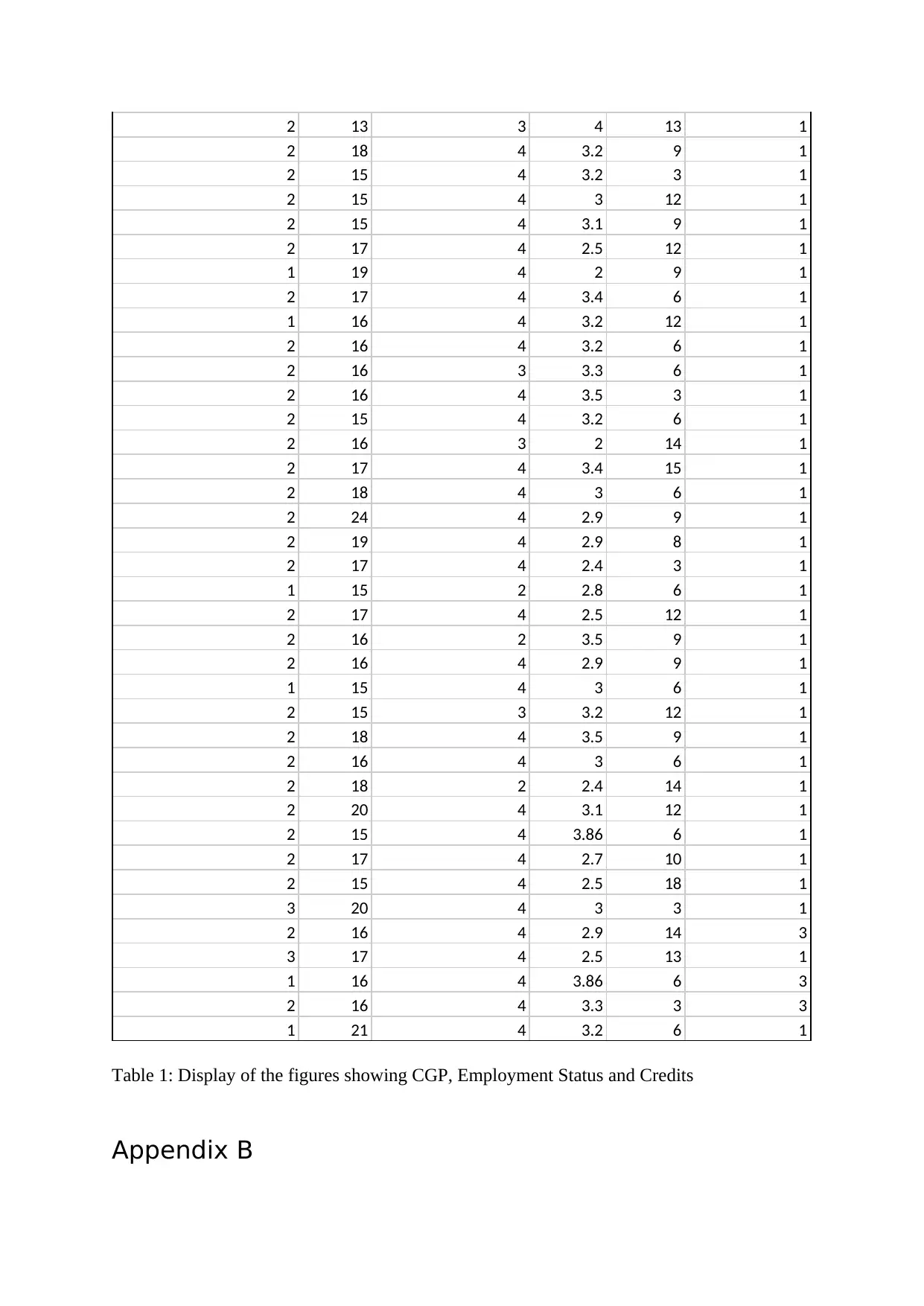
2 13 3 4 13 1
2 18 4 3.2 9 1
2 15 4 3.2 3 1
2 15 4 3 12 1
2 15 4 3.1 9 1
2 17 4 2.5 12 1
1 19 4 2 9 1
2 17 4 3.4 6 1
1 16 4 3.2 12 1
2 16 4 3.2 6 1
2 16 3 3.3 6 1
2 16 4 3.5 3 1
2 15 4 3.2 6 1
2 16 3 2 14 1
2 17 4 3.4 15 1
2 18 4 3 6 1
2 24 4 2.9 9 1
2 19 4 2.9 8 1
2 17 4 2.4 3 1
1 15 2 2.8 6 1
2 17 4 2.5 12 1
2 16 2 3.5 9 1
2 16 4 2.9 9 1
1 15 4 3 6 1
2 15 3 3.2 12 1
2 18 4 3.5 9 1
2 16 4 3 6 1
2 18 2 2.4 14 1
2 20 4 3.1 12 1
2 15 4 3.86 6 1
2 17 4 2.7 10 1
2 15 4 2.5 18 1
3 20 4 3 3 1
2 16 4 2.9 14 3
3 17 4 2.5 13 1
1 16 4 3.86 6 3
2 16 4 3.3 3 3
1 21 4 3.2 6 1
Table 1: Display of the figures showing CGP, Employment Status and Credits
Appendix B
2 18 4 3.2 9 1
2 15 4 3.2 3 1
2 15 4 3 12 1
2 15 4 3.1 9 1
2 17 4 2.5 12 1
1 19 4 2 9 1
2 17 4 3.4 6 1
1 16 4 3.2 12 1
2 16 4 3.2 6 1
2 16 3 3.3 6 1
2 16 4 3.5 3 1
2 15 4 3.2 6 1
2 16 3 2 14 1
2 17 4 3.4 15 1
2 18 4 3 6 1
2 24 4 2.9 9 1
2 19 4 2.9 8 1
2 17 4 2.4 3 1
1 15 2 2.8 6 1
2 17 4 2.5 12 1
2 16 2 3.5 9 1
2 16 4 2.9 9 1
1 15 4 3 6 1
2 15 3 3.2 12 1
2 18 4 3.5 9 1
2 16 4 3 6 1
2 18 2 2.4 14 1
2 20 4 3.1 12 1
2 15 4 3.86 6 1
2 17 4 2.7 10 1
2 15 4 2.5 18 1
3 20 4 3 3 1
2 16 4 2.9 14 3
3 17 4 2.5 13 1
1 16 4 3.86 6 3
2 16 4 3.3 3 3
1 21 4 3.2 6 1
Table 1: Display of the figures showing CGP, Employment Status and Credits
Appendix B
⊘ This is a preview!⊘
Do you want full access?
Subscribe today to unlock all pages.

Trusted by 1+ million students worldwide
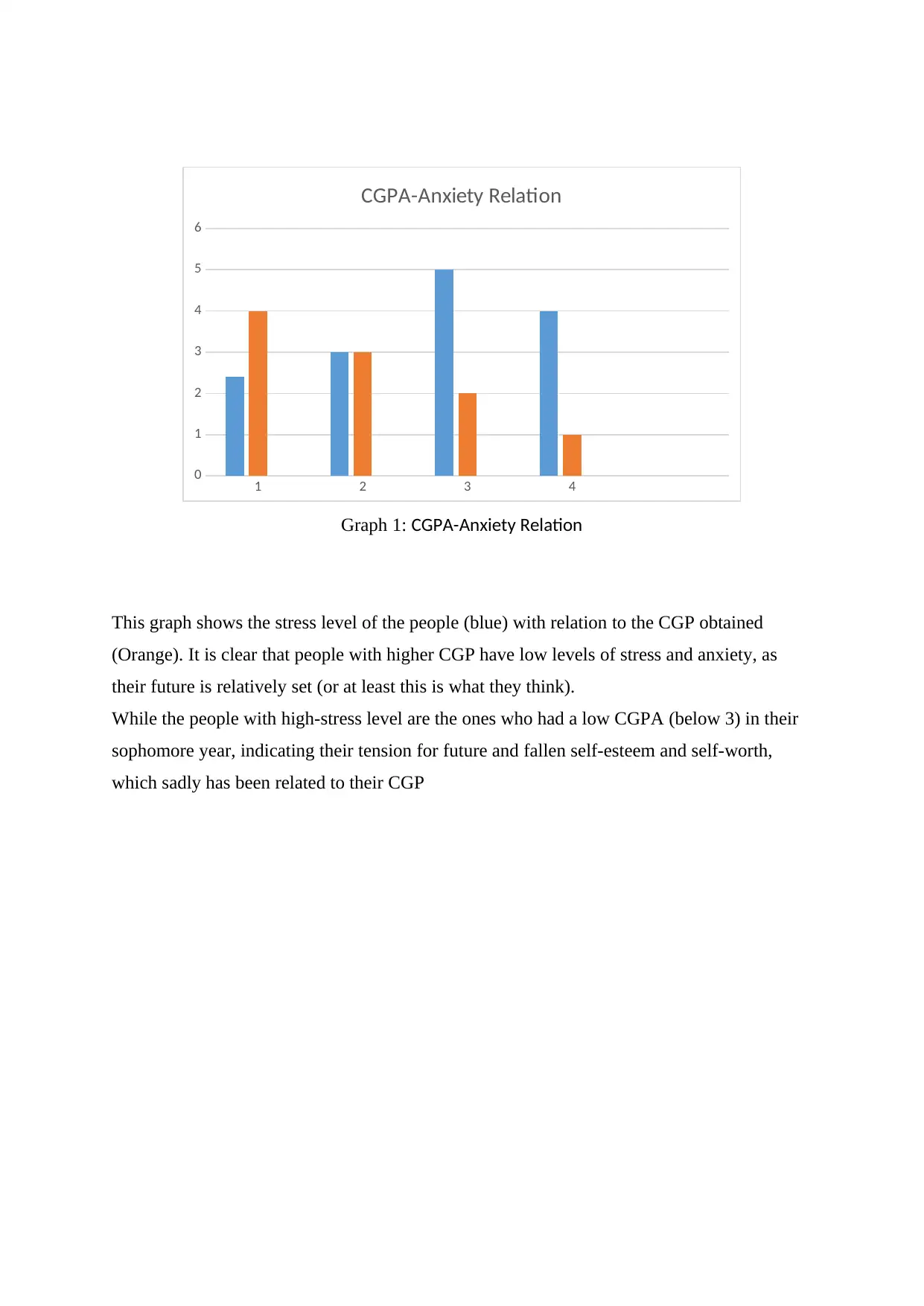
1 2 3 4
0
1
2
3
4
5
6
CGPA-Anxiety Relation
Graph 1: CGPA-Anxiety Relation
This graph shows the stress level of the people (blue) with relation to the CGP obtained
(Orange). It is clear that people with higher CGP have low levels of stress and anxiety, as
their future is relatively set (or at least this is what they think).
While the people with high-stress level are the ones who had a low CGPA (below 3) in their
sophomore year, indicating their tension for future and fallen self-esteem and self-worth,
which sadly has been related to their CGP
0
1
2
3
4
5
6
CGPA-Anxiety Relation
Graph 1: CGPA-Anxiety Relation
This graph shows the stress level of the people (blue) with relation to the CGP obtained
(Orange). It is clear that people with higher CGP have low levels of stress and anxiety, as
their future is relatively set (or at least this is what they think).
While the people with high-stress level are the ones who had a low CGPA (below 3) in their
sophomore year, indicating their tension for future and fallen self-esteem and self-worth,
which sadly has been related to their CGP
1 out of 13
Related Documents
Your All-in-One AI-Powered Toolkit for Academic Success.
+13062052269
info@desklib.com
Available 24*7 on WhatsApp / Email
![[object Object]](/_next/static/media/star-bottom.7253800d.svg)
Unlock your academic potential
© 2024 | Zucol Services PVT LTD | All rights reserved.





